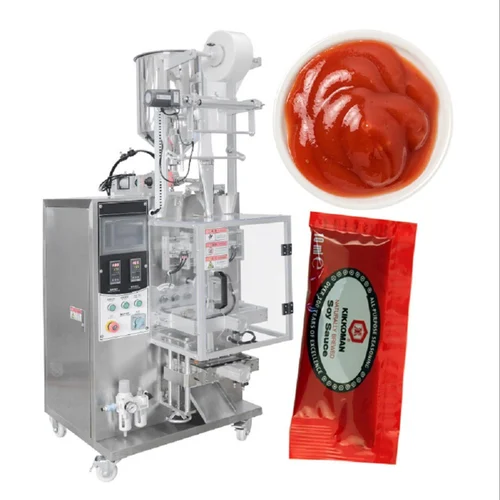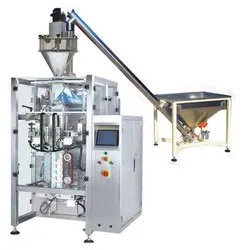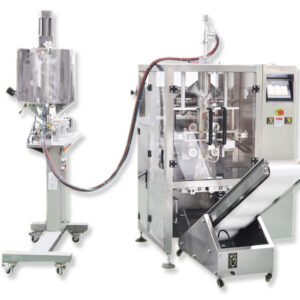Description
| Specification | Details |
|---|---|
| Filling Capacity | [Specify the range, e.g., 50ml to 1000ml] |
| Packing Speed | [Specify in units per minute] |
| Filling Accuracy | [Specify in percentage or ml/g accuracy] |
| Suitable Packaging Material | [e.g., PET bottles, glass jars, pouches] |
| Power Supply | [Specify voltage and frequency] |
| Power Consumption | [Specify in kW/h] |
| Control System | [PLC-based, touchscreen interface] |
| Material of Construction | [e.g., stainless steel 304] |
| Dimensions (L x W x H) | [Specify in mm or inches] |
| Weight | [Specify in kg or lbs] |
| Operating Environment | [Temperature and humidity range] |
| Air Pressure Requirement | [Specify in psi or bar] |
| Optional Features | [e.g., CIP system, automatic cap tightening] |
| Safety Features | [Emergency stop, safety guards] |
| Certifications | [CE, ISO, etc.] |
Introduction to Automatic Sauce Filling and Packing Machine
The automation of sauce filling and packaging machines has caused a revolution in the food processing industry by offering unprecedented efficiency, accuracy, and flexibility. This sophisticated equipment is used for filling vessels with various sauces including thin liquids and thick pastes that are then sealed and ready for shipping. As such, they increase the production rates by replacing manual labor while ensuring product volume consistency and accuracy. They can fit into any type of production due to their adjustable features as well as user-friendly interfaces thus making them ideal for small-scale providers or large factories. Additionally, their compliance with food safety requirements as well as easy-to-clean design ensures that sanitation prevails throughout the manufacturing process. In response to growing consumer demands for convenience and quality, automatic sauce filling and packing machines will increasingly assume greater importance in meeting these desires whilst promoting innovations in food processing.
Types of Automatic Sauce Filling and Packing Machines
Piston Fillers: These use pistons to measure out precise quantities of sauce into containers. They are best suited for thick sauces.
Gravity Fillers: Gravity fillers make use of gravity force only to fill up liquid sauce containers; they are perfect for thin free-flowing sauces.
Volumetric Fillers: Volumetric fillers measure out volumes of sauce to be dispensed into bottles. They have higher measuring accuracy that permits different viscosities of sauces.
Net Weight Fillers: Net weight fillers fill up containers using weight measurements only which is most useful when dealing with irregularly shaped or sized bottles.
How Automatic Sauce Filling and Packing Machines Work
Automatic sauce-filling machines are mechanisms that efficiently fill containers through various processes within the machine itself. The typical steps in this process include:
Container Feeding: Empty vessels are conveyed into the machine by a conveyor belt or other input mechanism.
Filling: The chosen method (piston, gravity, volumetric, or net weight) is used to pour the sauce into these containers.
Sealing: These filled vessels are sealed using lids, caps, or heat-sealing machines.
Labeling and Packaging: Containers are labeled and packaged after sealing before they can be released for distribution.
Features and Functions
Precision: Filling machines for sauces have measurement techniques that ensure the consistency of product volumes.
Speed: Production efficiency is significantly enhanced by the fast dispensing and packing of sauces in these machines.
Versatility: They can work with all types of densities of sauces right from liquid ones to pastes.
Customization: Different sizes, and shapes of containers, as well as various methods of sealing such as caps or lids can be accommodated in many models.
Hygiene: The surfaces that come into contact with the food being packed are designed for easy cleaning since they must conform to safety standards set for such materials used in food processing.
Integration: Automatic sauce-filling machines may thus be integrated into existing production lines so as not to disrupt operations while at the same time maximizing production efficiency and reducing downtime periods.
Benefits of Automatic Sauce Filling and Packing Machines
Increased Efficiency: Automation eliminates the need for manual labor hence increasing productivity through reducing workers’ time on a task-per-unit basis thereby decreasing labor costs due to high output rates.
Improved Accuracy: Accurate fillings increase uniformity across the board making it possible to avoid wastage when preparing products resulting in more satisfied customers in this regard; also enhances customer satisfaction by ensuring that each item is similar irrespective of whether it was produced earlier or later during any given day’s shift hours.
Cost Savings: When filling and packaging activities are automated, less money is spent on overheads leading to lower operational expenses which means greater profits made.
Enhanced Hygiene: Automated filling systems prevent contamination risks that might occur thus ensuring safe practices according to set guidelines in food processing.
Flexibility: These machines can adapt to shifting production needs and handle any kind of sauce.
Scalability: Automatic fillers are scalable as demand for production rises to meet the growing output.
Future Trends in Automatic Sauce Filling and Packing
Integration of AI and Machine Learning: The latest algorithms will optimize production processes, predicting maintenance demands and increasing efficiency.
IoT Connectivity: Machines fitted with sensors will be connected to the internet for remote control and monitoring functions.
Sustainable Packaging Solutions: Eco-friendly packaging materials and designs will take precedence with a view to minimizing environmental impact.
Robotics and Automation: Robotics will play an even greater role in activities such as container feeding and packaging among others thus further streamlining operations.
Enhanced User Interfaces: More user-friendly interfaces will make operation and maintenance easier thereby reducing training requirements.
FAQs
Are automatic sauce-filling machines suitable for small-scale producers?
Yes, there are models designed specifically for small-scale productions that offer flexibility at very low-cost rates
Can these machines handle sauces with particulates, such as chunks of vegetables or fruits?
Yes, there are certain models capable of handling such types of sauces. This ensures uniformity in the final product.
How do automatic machines ensure hygiene and food safety?
They are constructed using safe materials while many have been built based on hygienic design principles which allows ease of cleaning them hence reducing microbial contamination
What maintenance is required for automatic filling machines?
Cleaning regularly, lubricating parts, and checking them often all help keep the right performance standard which prolongs their useful life
Can automatic machines adjust filling volumes for different container sizes?
Certainly yes. Many models have system settings that allow operators to program desired levels depending on size specifications defined by shape or capacity among other attributes.
Are automatic machines compatible with various types of packaging materials?
Sure! They work well with numerous packages including glass containers, plastic bottles drums made from metallic substances or fibrous varieties plus lids and covers of different kinds.
What is the typical production capacity of automatic filling machines?
But it may range from a few hundred to several thousand containers per hour depending on the model and specifications.
Do automatic machines require skilled operators?
While advanced training in this field may be required, modern equipment has been designed with user-friendly interfaces and automated features hence reducing the need for highly skilled professionals
Can automatic filling machines handle hot-fill and cold-fill sauces?
Yes. Machines can be made for both hot fill and cold fill processes depending on how sauce requires being handled.
What are the energy requirements for operating automatic filling machines?
Machine size, production capacity, and process parameters are some of the factors that determine how much energy they consume. However, many manufacturers try to increase their efficiency by using modern technology that reduces power consumption.





